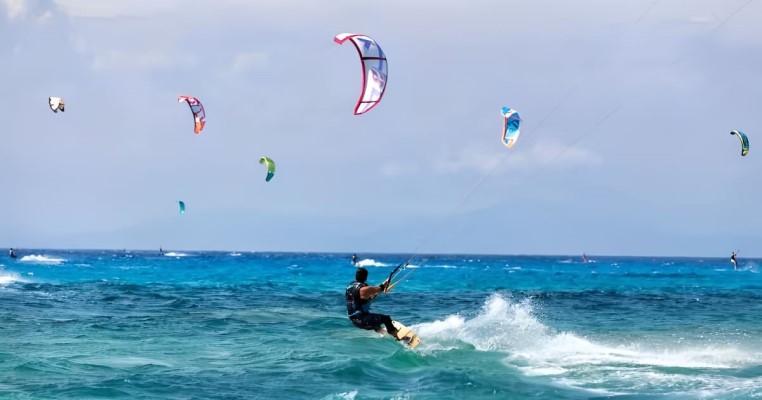Explore the exciting world of kitesurfing in this comprehensive beginner’s guide. Learn what equipment you need, how to stay safe, and get expert tips for a thrilling water adventure.
Kitesurfing, a fusion of wind power and surfing, has emerged as one of the world’s most thrilling water sports. In this comprehensive beginner’s guide, we’ll take you through the essentials of kitesurfing, from the equipment you’ll need to safety precautions and expert tips. Whether you’re new to water sports or an experienced surfer, kitesurfing offers an exhilarating experience that will challenge and reward you.
What You Need to Get Started
Before you hit the waves, it’s essential to gather the right equipment. Here’s what you’ll need:
1. A Kite
Kites come in various sizes and shapes, so choosing the right one is crucial. Factors like your skill level and wind conditions will influence your selection. Opt for a kite that suits your abilities and the weather.
2. A Control Bar
The control bar is your steering wheel in kitesurfing. It allows you to control the kite’s direction and power the board. Ensure it’s in good working condition before you start.
3. Lines
Lines connect the kite to the control bar, transmitting your commands to the kite. Check for any wear or damage on the lines regularly to ensure safe kiting.
4. A Harness
Worn around your waist, the harness attaches you to the kite, giving you control and stability. Make sure it fits comfortably and securely.
5. A Board
Kitesurfing boards come in various sizes and shapes. The choice depends on your skill level and the wind conditions. Consult with experts to select the right board for you.
You can either rent or buy kitesurfing equipment from reputable schools and shops.
Taking Lessons
The best way to embark on your kitesurfing journey is to enroll in lessons with a qualified instructor. These lessons cover crucial aspects of the sport, including:
Kite Safety and Setup
Learn how to set up your kite safely and understand the equipment.
Kite Control
Master the art of controlling the kite’s movements and direction.
Body Positioning and Board Control
Achieve balance on the board and control your movements on the water.
Water Start
Learn how to start from the water efficiently, a crucial skill for kitesurfers.
Riding and Control
Advance to riding the waves confidently and controlling your board.
Safety First
While kitesurfing is relatively safe, it’s essential to be aware of potential risks and take precautions to ensure a safe experience. Follow these safety tips:
- Always wear a helmet and a personal flotation device (PFD) for added safety.
- Never go kitesurfing alone; having a buddy can be a lifesaver.
- Stay informed about wind conditions and avoid kiting in strong winds or gusty conditions.
- Be vigilant of your surroundings, including other kitesurfers sharing the waters.
Getting Started
Once you’ve acquired the necessary skills and equipment, you’re ready to hit the water. Here are some helpful tips for your first kitesurfing sessions:
- Begin in a shallow, flat-water area to build your confidence.
- Start with a large kite and a small board; this combination makes it easier for beginners.
- Focus on perfecting your water start, as it’s a fundamental skill.
- As you gain consistency in getting up and riding, progress to refining your riding skills.
Tips for Beginners
Starting any new sport can be challenging, but with kitesurfing, perseverance pays off. Here are some valuable tips for beginners:
- Be patient; kitesurfing requires time and practice to master.
- Don’t fear falling; every kitesurfer, even the pros, has taken a tumble while learning.
- Most importantly, have fun! Kitesurfing is not just a sport; it’s an opportunity to enjoy the great outdoors and challenge yourself.
Frequently Asked Questions (FAQs)
Q: Is kitesurfing suitable for beginners?
A: Yes, kitesurfing is beginner-friendly, especially if you take lessons from a qualified instructor.
Q: Do I need to be an experienced surfer to start kitesurfing?
A: No, prior experience in surfing or windsurfing can be helpful but is not a prerequisite for learning kitesurfing.
Q: How long does it take to become proficient in kitesurfing?
A: The time it takes to become proficient varies from person to person, but with consistent practice and guidance, you can progress quickly.
Q: Can I kitesurf alone?
A: It is not recommended to kitesurf alone; always have a buddy with you for safety reasons.
Q: What’s the best type of kite for a beginner?
A: Larger kites are generally better for beginners as they offer more stability and ease of control.
Q: Is kitesurfing safe?
A: Kitesurfing is relatively safe when practiced in safe conditions and with proper safety measures in place.
Conclusion
Kitesurfing is a thrilling and rewarding water sport that offers a unique blend of adventure and outdoor enjoyment. Whether you’re looking for an adrenaline rush or a new way to challenge yourself, kitesurfing has it all. Remember to prioritize safety, take lessons from qualified instructors, and most importantly, have fun riding the wind and waves.


Kitesurfing, often referred to as kiteboarding, is an exhilarating water sport that combines elements of surfing, windsurfing, and flying a kite. It’s a fantastic way to connect with nature and experience the thrill of harnessing the power of the wind and waves.